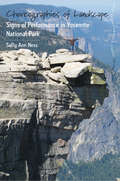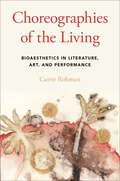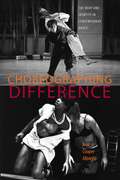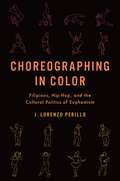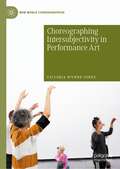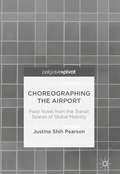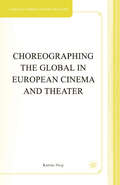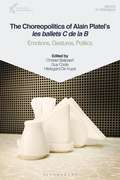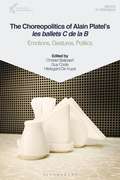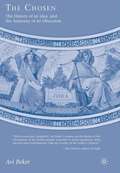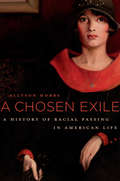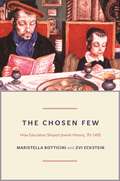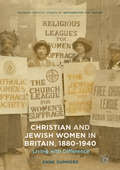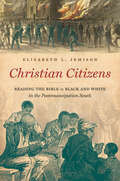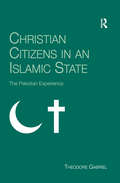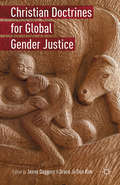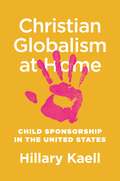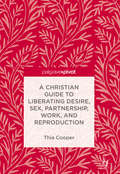- Table View
- List View
Choreographies of Landscape: Signs of Performance in Yosemite National Park (Dance and Performance Studies #8)
by Sally Ann NessAs an international ecotourism destination, Yosemite National Park welcomes millions of climbers, sightseers, and other visitors from around the world annually, all of whom are afforded dramatic experiences of the natural world. This original and cross-disciplinary book offers an ethnographic and performative study of Yosemite visitors in order to understand human connection with and within natural landscapes. By grounding a novel “eco-semiotic” analysis in the lived reality of parkgoers, it forges surprising connections, assembling a collective account that will be of interest to disciplines ranging from performance studies to cultural geography.
Choreographies of the Living: Bioaesthetics in Literature, Art, and Performance
by Carrie RohmanChoreographies of the Living explores the implications of shifting from viewing art as an exclusively human undertaking to recognizing it as an activity that all living creatures enact. Carrie Rohman reveals the aesthetic impulse itself to be profoundly trans-species, and in doing so she revises our received wisdom about the value and functions of artistic capacities. Countering the long history of aesthetic theory in the West--beginning with Plato and Aristotle, and moving up through the recent claims of "neuroaesthetics"--Rohman challenges the likening of aesthetic experience to an exclusively human form of judgment. Turning toward the animal in new frameworks for understanding aesthetic impulses, Rohman emphasizes a deep coincidence of humans' and animals' elaborations of fundamental life forces. Examining a range of literary, visual, dance, and performance works and processes by modernist and contemporary figures such as Isadora Duncan, D. H. Lawrence, Virginia Woolf, and Merce Cunningham, Rohman reconceives the aesthetic itself not as a distinction separating humans from other animals, but rather as a framework connecting embodied beings. Her view challenges our species to acknowledge the shared status of art-making, one of our most hallowed and formerly exceptional activities.
CHOREOGRAPHIES OF THE LIVING C: Bioaesthetics in Literature, Art, and Performance
by Carrie RohmanChoreographies of the Living explores the implications of shifting from viewing art as an exclusively human undertaking to recognizing it as an activity that all living creatures enact. Carrie Rohman reveals the aesthetic impulse itself to be profoundly trans-species, and in doing so she revises our received wisdom about the value and functions of artistic capacities. Countering the long history of aesthetic theory in the West--beginning with Plato and Aristotle, and moving up through the recent claims of "neuroaesthetics"--Rohman challenges the likening of aesthetic experience to an exclusively human form of judgment. Turning toward the animal in new frameworks for understanding aesthetic impulses, Rohman emphasizes a deep coincidence of humans' and animals' elaborations of fundamental life forces. Examining a range of literary, visual, dance, and performance works and processes by modernist and contemporary figures such as Isadora Duncan, D. H. Lawrence, Virginia Woolf, and Merce Cunningham, Rohman reconceives the aesthetic itself not as a distinction separating humans from other animals, but rather as a framework connecting embodied beings. Her view challenges our species to acknowledge the shared status of art-making, one of our most hallowed and formerly exceptional activities.
Choreographing Difference: The Body and Identity in Contemporary Dance
by Ann Cooper AlbrightThe choreographies of Bill T. Jones, Cleveland Ballet Dancing Wheels, Zab Maboungou, David Dorfman, Marie Chouinard, Jawole Willa Jo Zollar, and others, have helped establish dance as a crucial discourse of the 90s. These dancers, Ann Cooper Albright argues, are asking the audience to see the body as a source of cultural identity — a physical presence that moves with and through its gendered, racial, and social meanings.Through her articulate and nuanced analysis of contemporary choreography, Albright shows how the dancing body shifts conventions of representation and provides a critical example of the dialectical relationship between cultures and the bodies that inhabit them. As a dancer, feminist, and philosopher, Albright turns to the material experience of bodies, not just the body as a figure or metaphor, to understand how cultural representation becomes embedded in the body. In arguing for the intelligence of bodies, Choreographing Difference is itself a testimonial, giving voice to some important political, moral, and artistic questions of our time.
Choreographing in Color: Filipinos, Hip-Hop, and the Cultural Politics of Euphemism
by J. Lorenzo PerilloIn Choreographing in Color , J. Lorenzo Perillo investigates the development of Filipino popular dance and performance since the late 20th century. Drawing from nearly two decades of ethnography, choreographic analysis, and community engagement with artists, choreographers, and organizers, Perillo shifts attention away from the predominant Philippine neoliberal and U.S. imperialist emphasis on Filipinos as superb mimics, heroic migrants, model minorities, subservient wives, and natural dancers and instead asks: what does it mean for Filipinos to navigate the violent forces of empire and neoliberalism with street dance and Hip-Hop? Employing critical race, feminist, and performance studies, Perillo analyzes the conditions of possibility that gave rise to Filipino dance phenomena across viral, migrant, theatrical, competitive, and diplomatic performance in the Philippines and diaspora. Advocating for serious engagements with the dancing body, Perillo rethinks a staple of Hip-Hop's regulation, the "euphemism," as a mode of social critique for understanding how folks have engaged with both racial histories of colonialism and gendered labor migration. Figures of euphemism - the zombie, hero, robot, and judge - constitute a way of seeing Filipino Hip-Hop as contiguous with a multi-racial repertoire of imperial crossing, thus uncovering the ways Black dance intersects Filipino racialization and reframing the ongoing, contested underdog relationship between Filipinos and U.S. global power. Choreographing in Color therefore reveals how the Filipino dancing body has come to be, paradoxically, both globally recognized and indiscernible.
CHOREOGRAPHING IN COLOR C: Filipinos, Hip-Hop, and the Cultural Politics of Euphemism
by J. Lorenzo PerilloIn Choreographing in Color , J. Lorenzo Perillo investigates the development of Filipino popular dance and performance since the late 20th century. Drawing from nearly two decades of ethnography, choreographic analysis, and community engagement with artists, choreographers, and organizers, Perillo shifts attention away from the predominant Philippine neoliberal and U.S. imperialist emphasis on Filipinos as superb mimics, heroic migrants, model minorities, subservient wives, and natural dancers and instead asks: what does it mean for Filipinos to navigate the violent forces of empire and neoliberalism with street dance and Hip-Hop? Employing critical race, feminist, and performance studies, Perillo analyzes the conditions of possibility that gave rise to Filipino dance phenomena across viral, migrant, theatrical, competitive, and diplomatic performance in the Philippines and diaspora. Advocating for serious engagements with the dancing body, Perillo rethinks a staple of Hip-Hop's regulation, the "euphemism," as a mode of social critique for understanding how folks have engaged with both racial histories of colonialism and gendered labor migration. Figures of euphemism - the zombie, hero, robot, and judge - constitute a way of seeing Filipino Hip-Hop as contiguous with a multi-racial repertoire of imperial crossing, thus uncovering the ways Black dance intersects Filipino racialization and reframing the ongoing, contested underdog relationship between Filipinos and U.S. global power. Choreographing in Color therefore reveals how the Filipino dancing body has come to be, paradoxically, both globally recognized and indiscernible.
Choreographing Intersubjectivity in Performance Art (New World Choreographies)
by Victoria Wynne-JonesThis book offers new ways of thinking about dance-related artworks that have taken place in galleries, museums and biennales over the past two decades as part of the choreographic turn. It focuses on the concept of intersubjectivity and theorises about what happens when subjects meet within a performance artwork. The resulting relations are crucial to instances of performance art in which embodied subjects engage as spectators, participants and performers in orchestrated art events. Choreographing Intersubjectivity in Performance Art deploys a multi-disciplinary approach across dance choreography and evolving manifestations of performance art. An innovative, overarching concept of choreography sustains the idea that intersubjectivity evolves through places, spaces, performance and spectatorship. Drawing upon international examples, the book introduces readers to performance art from the South Pacific and the complexities of de-colonising choreography. Artists Tino Sehgal, Xavier Le Roy, Jordan Wolfson, Alicia Frankovich and Shigeyuki Kihara are discussed.
Choreographing the Airport: Field Notes from the Transit Spaces of Global Mobility (PDF)
by Justine Shih PearsonThis book investigates the global hub airport as an exemplar of cosmopolitan culture and space. A machine made for movement, itself perched at the crossroads of the world’s incessant mobility, the airport is both a symbol of and stage for the ways in which we construct and inhabit the world today.Taking an ethnographically-inflected approach, this study brings together knowledge of the moving body from dance and performance and the study of systems of mobility within cultural and mobilities studies, in order to call attention to the kinaesthetic experience of global space. What is the choreography of the global airport? How does it perform on us. How do we perform within it?Extending thinking about contemporary cosmopolitanism and cultural identity, and the performativity of places and identities, this book is essential reading for those interested in cultural debates around globalisation, the innovative application of performance theory towards everyday experience, and interdisciplinary methodologies.
Choreographing the Global in European Cinema and Theater (Studies in European Culture and History)
by K. SiegThe book explores European artists' critical engagement with the images and stories that politicians and the media use to advocate globalization.
The Choreopolitics of Alain Platel's les ballets C de la B: Emotions, Gestures, Politics (Dance in Dialogue)
by Christel Stalpaert Guy Cools Hildegard De VuystLes Ballets C de la B was founded by Alain Platel in 1984. Since then it has become a company that enjoys great success at home and abroad. Over the years, Platel has developed a unique choreographic oeuvre. His motto, 'This dance is for the world and the world is for everyone', reveals a deep social and political commitment.Through the three topics of emotions, gestures and politics, this book unravels the choreopolitics of Platel's Les Ballets C de la B. His choreopolitics go beyond conveying a (political) message because rather than defending one opinion, Platel is more concerned about the exposure of the complexity within the debate itself. Highly respected scholars from different fields contribute to this book to provide an interdisciplinary perspective on the intense emotions, the damaged narratives, and the precarious bodies in Platel's choreographic oeuvre.
The Choreopolitics of Alain Platel's les ballets C de la B: Emotions, Gestures, Politics (Dance in Dialogue)
by Christel Stalpaert Guy Cools Hildegard De VuystLes Ballets C de la B was founded by Alain Platel in 1984. Since then it has become a company that enjoys great success at home and abroad. Over the years, Platel has developed a unique choreographic oeuvre. His motto, 'This dance is for the world and the world is for everyone', reveals a deep social and political commitment.Through the three topics of emotions, gestures and politics, this book unravels the choreopolitics of Platel's Les Ballets C de la B. His choreopolitics go beyond conveying a (political) message because rather than defending one opinion, Platel is more concerned about the exposure of the complexity within the debate itself. Highly respected scholars from different fields contribute to this book to provide an interdisciplinary perspective on the intense emotions, the damaged narratives, and the precarious bodies in Platel's choreographic oeuvre.
The Chosen: The History of an Idea, the Anatomy of an Obsession
by A. BekerThe Chosen explores Judaism s key defining concept and inquires why it remains the central unspoken and explosive psychological, historical, and theological problem at the heart of Jewish-Gentile relations. Crisscrossing the twin cultural and theological divides between Judaism, Christendom, and Islam, The Chosen explains how the Jews, of all people, have come to represent at once the epitome of both the good and the odious. Beker covers not only the great stories of how the Jews came to be chosen and the Christian, Muslim, and Nazi efforts to appropriate the title, but also the key role "chosenness" plays in contemporary anti-Semitism and in the current Middle East conflict over the Land of Israel and the chosen city of Jerusalem.
A Chosen Exile: A History of Racial Passing in American Life
by Allyson HobbsCountless African Americans have passed as white, leaving behind families and friends, roots and communities. It was, as Allyson Hobbs writes, a chosen exile. This history of passing explores the possibilities, challenges, and losses that racial indeterminacy presented to men and women living in a country obsessed with racial distinctions.
A Chosen Exile: A History of Racial Passing in American Life
by Allyson HobbsCountless African Americans have passed as white, leaving behind families and friends, roots and communities. It was, as Allyson Hobbs writes, a chosen exile. This history of passing explores the possibilities, challenges, and losses that racial indeterminacy presented to men and women living in a country obsessed with racial distinctions.
The Chosen Few: How Education Shaped Jewish History, 70-1492
by Maristella Botticini Zvi EcksteinIn 70 CE, the Jews were an agrarian and illiterate people living mostly in the Land of Israel and Mesopotamia. By 1492 the Jewish people had become a small group of literate urbanites specializing in crafts, trade, moneylending, and medicine in hundreds of places across the Old World, from Seville to Mangalore. What caused this radical change? The Chosen Few presents a new answer to this question by applying the lens of economic analysis to the key facts of fifteen formative centuries of Jewish history. Maristella Botticini and Zvi Eckstein offer a powerful new explanation of one of the most significant transformations in Jewish history while also providing fresh insights into the growing debate about the social and economic impact of religion.
The Chosen Few: How Education Shaped Jewish History, 70-1492
by Maristella Botticini Zvi EcksteinIn 70 CE, the Jews were an agrarian and illiterate people living mostly in the Land of Israel and Mesopotamia. By 1492 the Jewish people had become a small group of literate urbanites specializing in crafts, trade, moneylending, and medicine in hundreds of places across the Old World, from Seville to Mangalore. What caused this radical change? The Chosen Few presents a new answer to this question by applying the lens of economic analysis to the key facts of fifteen formative centuries of Jewish history. Maristella Botticini and Zvi Eckstein offer a powerful new explanation of one of the most significant transformations in Jewish history while also providing fresh insights into the growing debate about the social and economic impact of religion.
Christian and Jewish Women in Britain, 1880-1940: Living with Difference
by Anne SummersThis book offers an entirely new contribution to the history of multiculturalism in Britain, 1880-1940. It shows how friendship and co-operation between Christian and Jewish women changed lives and, as the Second World War approached, actually saved them. The networks and relationships explored include the thousand-plus women from every district in Manchester who combined to send a letter of sympathy to the Frenchwoman at the heart of the Dreyfus Affair; the religious leagues for women’s suffrage who initiated the first interfaith campaigning movement in British history; the collaborations, often problematic, on refugee relief in the 1930s; the close ties between the founder of Liberal Judaism in Britain, and the wife of the leader of the Labour Party, between the wealthy leader of the Zionist women’s movement and a passionate socialist woman MP. A great variety of sources are thoughtfully interrogated, and concluding remarks address some of the social concerns of the present century.
Christian and Jewish Women in Britain, 1880-1940: Living with Difference
by Anne SummersThis book offers an entirely new contribution to the history of multiculturalism in Britain, 1880-1940. It shows how friendship and co-operation between Christian and Jewish women changed lives and, as the Second World War approached, actually saved them. The networks and relationships explored include the thousand-plus women from every district in Manchester who combined to send a letter of sympathy to the Frenchwoman at the heart of the Dreyfus Affair; the religious leagues for women’s suffrage who initiated the first interfaith campaigning movement in British history; the collaborations, often problematic, on refugee relief in the 1930s; the close ties between the founder of Liberal Judaism in Britain, and the wife of the leader of the Labour Party, between the wealthy leader of the Zionist women’s movement and a passionate socialist woman MP. A great variety of sources are thoughtfully interrogated, and concluding remarks address some of the social concerns of the present century.
Christian Citizens: Reading the Bible in Black and White in the Postemancipation South
by Elizabeth L. JemisonWith emancipation, a long battle for equal citizenship began. Bringing together the histories of religion, race, and the South, Elizabeth L. Jemison shows how southerners, black and white, drew on biblical narratives as the basis for very different political imaginaries during and after Reconstruction. Focusing on everyday Protestants in the Mississippi River Valley, Jemison scours their biblical thinking and religious attitudes toward race. She argues that the evangelical groups that dominated this portion of the South shaped contesting visions of black and white rights. Black evangelicals saw the argument for their identities as Christians and as fully endowed citizens supported by their readings of both the Bible and U.S. law. The Bible, as they saw it, prohibited racial hierarchy, and Amendments 13, 14, and 15 advanced equal rights. Countering this, white evangelicals continued to emphasize a hierarchical paternalistic order that, shorn of earlier justifications for placing whites in charge of blacks, now fell into the defense of an increasingly violent white supremacist social order. They defined aspects of Christian identity so as to suppress black equality—even praying, as Jemison documents, for wisdom in how to deny voting rights to blacks. This religious culture has played into remarkably long-lasting patterns of inequality and segregation.
Christian Citizens in an Islamic State: The Pakistan Experience
by Theodore GabrielChristian Citizens in an Islamic State deals with the important question of inter-faith relations in Pakistan, a vital region of the Islamic world which has been the scene of the rise of both Islamic militancy and partnership with the West in counter-terrorism measures. Christians are the most important religious minority of Pakistan and their status and experience is a test case of the treatment of religious minorities in an Islamic state. This book covers new ground in exploring the various factors that govern the relations between Muslims and Christians in a nation state which has been politically unstable in the past, and where the imposition of Islamic law has been controversial and problematic for religious minorities. Theodore Gabriel clarifies the history of Christian-Muslim relations in the region, explores the rise of Islamic militancy, and draws on personal interviews to determine the mind set of both Christians and Muslims in Pakistan today.
Christian Citizens in an Islamic State: The Pakistan Experience
by Theodore GabrielChristian Citizens in an Islamic State deals with the important question of inter-faith relations in Pakistan, a vital region of the Islamic world which has been the scene of the rise of both Islamic militancy and partnership with the West in counter-terrorism measures. Christians are the most important religious minority of Pakistan and their status and experience is a test case of the treatment of religious minorities in an Islamic state. This book covers new ground in exploring the various factors that govern the relations between Muslims and Christians in a nation state which has been politically unstable in the past, and where the imposition of Islamic law has been controversial and problematic for religious minorities. Theodore Gabriel clarifies the history of Christian-Muslim relations in the region, explores the rise of Islamic militancy, and draws on personal interviews to determine the mind set of both Christians and Muslims in Pakistan today.
Christian Doctrines for Global Gender Justice
by Grace Ji-Sun Kim Jenny DaggersThis book develops creative imagining of traditional doctrines. Chapters show the effectiveness of Latina/mujerista, evangélica, womanist, Asian American, and white feminist imaginings in the furthering of global gender justice.
Christian Globalism at Home: Child Sponsorship in the United States
by Christian Global Hillary KaellAn exploration of how ordinary U.S. Christians create global connections through the multibillion-dollar child sponsorship industryChild sponsorship emerged from nineteenth-century Protestant missions to become one of today’s most profitable private fund-raising tools in organizations including World Vision, Compassion International, and ChildFund. Investigating two centuries of sponsorship and its related practices in American living rooms, churches, and shopping malls, Christian Globalism at Home reveals the myriad ways that Christians who don’t travel outside of the United States cultivate global sensibilities.Kaell traces the movement of money, letters, and images, along with a wide array of sponsorship’s lesser-known embodied and aesthetic techniques, such as playacting, hymn singing, eating, and fasting. She shows how, through this process, U.S. Christians attempt to hone globalism of a particular sort by oscillating between the sensory experiences of a God’s eye view and the intimacy of human relatedness. These global aspirations are buoyed by grand hopes and subject to intractable limitations, since they so often rely on the inequities they claim to redress.Based on extensive interviews, archival research, and fieldwork, Christian Globalism at Home explores how U.S. Christians imagine and experience the world without ever leaving home.
Christian Globalism at Home: Child Sponsorship in the United States
by Christian Global Hillary KaellAn exploration of how ordinary U.S. Christians create global connections through the multibillion-dollar child sponsorship industryChild sponsorship emerged from nineteenth-century Protestant missions to become one of today’s most profitable private fund-raising tools in organizations including World Vision, Compassion International, and ChildFund. Investigating two centuries of sponsorship and its related practices in American living rooms, churches, and shopping malls, Christian Globalism at Home reveals the myriad ways that Christians who don’t travel outside of the United States cultivate global sensibilities.Kaell traces the movement of money, letters, and images, along with a wide array of sponsorship’s lesser-known embodied and aesthetic techniques, such as playacting, hymn singing, eating, and fasting. She shows how, through this process, U.S. Christians attempt to hone globalism of a particular sort by oscillating between the sensory experiences of a God’s eye view and the intimacy of human relatedness. These global aspirations are buoyed by grand hopes and subject to intractable limitations, since they so often rely on the inequities they claim to redress.Based on extensive interviews, archival research, and fieldwork, Christian Globalism at Home explores how U.S. Christians imagine and experience the world without ever leaving home.
A Christian Guide to Liberating Desire, Sex, Partnership, Work, and Reproduction (PDF)
by Thia CooperWhat is good sex from the perspective of liberation theology? Thia Cooper argues that sex can be a way to know God. God created humans with a desire to be in relation with each other. From this understanding, sexual desire, sex, and partnerships are re-imagined positively. Good sex is enjoyable and mutual, an aspect of communion. Good sexual relationships share power, empower the participants, and the wider community. From the perspective of liberation theologies and an analysis of biblical texts, the Christian tradition, and the reality of our sexual experience, this book reframes theologies of partnership, sex work, and reproduction through the celebration of desire and sex.
